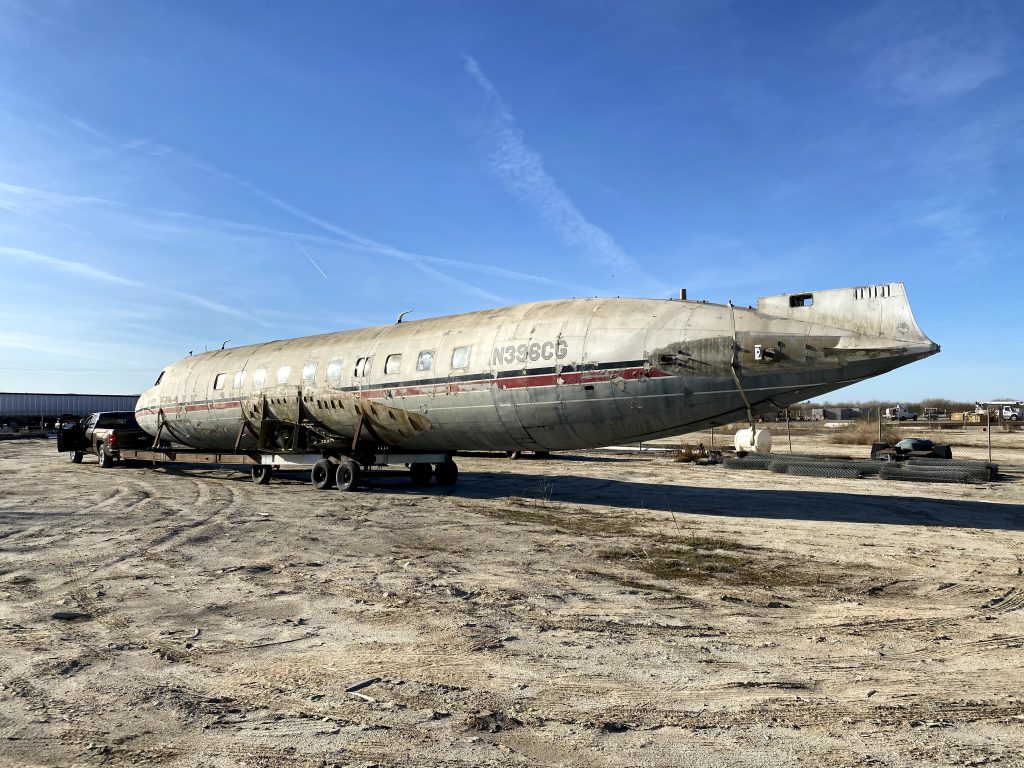
Convair 240 N396CG
Introduction
The Convair 240, registration N396CG, is a historic airliner that epitomizes the innovation of post-World War II aviation. Built in 1948 by Convair, this CV-240-5 (construction number 93) served commercial airlines, high-profile owners, and now stands as a preserved artifact in our museum. With its advanced features for its time, such as cabin pressurization and tricycle landing gear, N396CG represents a significant chapter in aviation history.
History
N396CG began its journey with Trans Australia Airlines (TAA) as VH-TAS, delivered in October 1948. One of five CV-240s operated by TAA, it brought modern air travel to Australia. In November 1959, it was exported to the United States as N9313R. Over the years, it was owned by notable figures, including actor Cary Grant, aviation pioneer Howard Hughes, and Faberge Inc., and served as a personal transport for singer Glenn Campbell. By 1994, it was based at Camarillo Airport, California. Deemed non-airworthy in 1999, it was stored until the California Air Heritage Foundation acquired it in 2009. Dismantled and moved to Shafter Minter Field, California, by 2010, N396CG now resides in our museum, showcasing its remarkable legacy.
Design Features
The Convair 240 was designed for efficiency and passenger comfort. Its all-metal construction, low-wing monoplane design, and twin Pratt & Whitney R-2800 Double Wasp radial engines (2,400 hp each) made it a reliable short- to medium-haul airliner. N396CG features a pressurized cabin, a rarity for its era, and tricycle landing gear for improved ground handling. The aircraft’s sleek design includes a 91 ft 9 in (27.97 m) wingspan and a streamlined fuselage, accommodating 40 passengers and a crew of three (two pilots and one flight attendant).
Specifications
| Specification | Details |
|---|---|
| Manufacturer | Convair |
| Model | CV-240-5 |
| First Flight | March 16, 1947 (CV-240 series) |
| Registration | N396CG |
| Construction Number | 93 |
| Crew | 3 (2 pilots, 1 flight attendant) |
| Passenger Capacity | 40 |
| Wingspan | 91 ft 9 in (27.97 m) |
| Length | 74 ft 8 in (22.76 m) |
| Height | 26 ft 11 in (8.20 m) |
| Empty Weight | 29,000 lb (13,154 kg) |
| Max Takeoff Weight | 42,500 lb (19,278 kg) |
| Powerplant | 2 × Pratt & Whitney R-2800 Double Wasp, 2,400 hp (1,790 kW) each |
| Fuel Capacity | 1,000 U.S. gallons (3,785 L) |
Flight Characteristics
The Convair 240 was known for its robust performance and reliability. With a cruising speed of 280 mph (450 km/h) and a range of 1,200 miles (1,930 km), it was well-suited for regional routes. Its service ceiling of 25,000 ft (7,620 m) and climb rate of 1,520 ft/min (7.7 m/s) allowed it to navigate varied terrains. Pilots appreciated its responsive handling and stability, though its radial engines required diligent maintenance. The pressurized cabin ensured passenger comfort at higher altitudes, a significant advancement for the 1940s.
Museum Significance
N396CG’s journey from commercial airliner to celebrity transport and now a museum piece reflects the Convair 240’s versatility and enduring appeal. Its preservation highlights the technological advancements of its era and the cultural significance of its famous owners. Visitors to our museum can explore this aircraft’s story, from its flights across Australia to its Hollywood connections.

Ownership History:
Ordered new by Trans Australia Airlines
Construction completed at the San Diego plant – September 21, 1948
Serial Number 93
Entered onto Australian Aircraft Register as VH-TAS – October 8, 1948
Registered to Australian National Airlines Commission
Departed San Diego on delivery flight to Australia – October 1948
Arrived Melbourne at conclusion of delivery flight – October 24, 1948
Delivery route: London – Rome – Nicosia – Basra – Karachi – Delhi – Calcutta – Rangoon – Singapore – Makasar – Darwin – Alice Springs – Adelaide – Melbourne
Aircraft was named ‘James Cook’ & later ‘Thomas Mitchell’
Operated first revenue service – November 3, 1948
Established a speed record for flight Melbourne-Hobart of 74 minutes – March 27, 1954
Withdrawn from use and stored at Melbourne’s Essendon Airport
Sold to Pakistan International Airlines – July 4, 1956
Departed Melbourne on delivery flight to Pakistan – July 7, 1956
Arrived Karachi at conclusion of delivery flight – July 8, 1956
Delivery route: Alice Springs – Darwin – Sourabaya – Singapore – Bangkok – Rangoon – Calcutta – New Delhi – Karachi
Cancelled from Australian Aircraft Register – July 13, 1956
Entered onto the Pakistan Aircraft Register as AP-AHS
Sold to N.V. Fokker as a trade for Pakistan International Airlines Friendship – October 17, 1959
Entered onto the Dutch Aircraft Register as PH-NLP
Operated by Euravia Air Charter N.V.
Sold to Beldex Corporation – July 6, 1960
Entered onto the U.S. Aircraft Register as N559R
Ferried to St Louis for fitment of executive interior by Remmert-Warner
Sold to Peabody Coal Company, St Louis – January 6, 1961
Sold to Louis Larramore, California – September 30, 1961
Reregistered as N559L
Sold to Beldex Corporation – May 11, 1962
Reregistered as N568R
Sold to Stephens Inc, Little Rock, Arizona – February 14, 1963
Sold to Little Rock Airmotive, then to Faberge Inc – September 21, 1970
Reregistered as N396CG for Cary Grant
Sold to Western Commander Inc – August 22, 1972
Ownership transferred to Western Leasing Corporation – August 23, 1972
Sold to the Summa Corportation (Howard Hughes) – August 21, 1974
Sold to Kings Point Corporation, Las Vagas – February 25, 1977
Sold to Gemini Management Corporation, Tulsa, Oklahoma – November 9, 1977
Sold to H. A. Cousins, Bloomfield Hills, Michigan – July 24, 1980
Cancelled from the U.S. Aircraft Register – February 20, 1981
Placed in storage at Pontiac Airport, Michigan
Restored to the U.S. Aircraft Register as N396CG
Sold to C & M Airways Inc, Longview, Texas – August 25, 1989
Sold to Garr Aero Inc, Stillwater, Oklahoma – November 29, 1989
Sold to R. Stevenson, Haskell, Oklahoma – January 5, 1990
Sold to Gunnell Aviation Inc, Santa Monica, California – June 1991
Sold to E. A. Schnepf, Tucson, Arizona – October 29, 1993
Used as a personal transport by singer Glenn Campbell
Withdrawn from service and stored at Camarillo Airport, California as non airworthy – 1999
Reportedly being held in storage for a Camarillo museum since 2003
Acquired by California Air Heritage Foundation – August 2009
Observed being dismantled at Camarillo Airport – August / October 2010
Acquired by the Golden Age Flight Museum – 2016
Moved from Camarillo Airport to Shafter Minter Field, CA.
Awaiting Restoration – Golden Age Flight Museum

